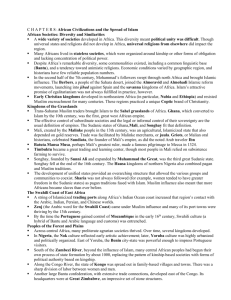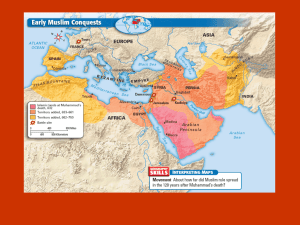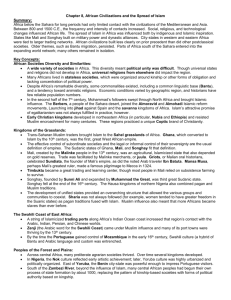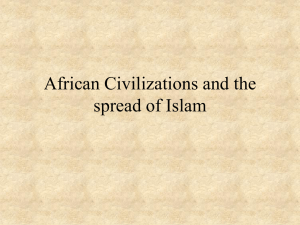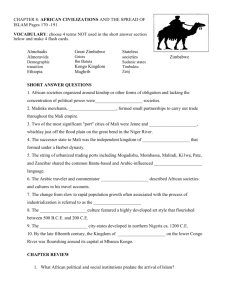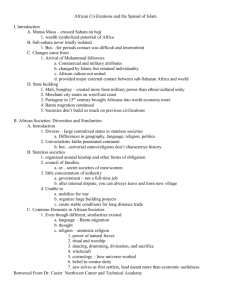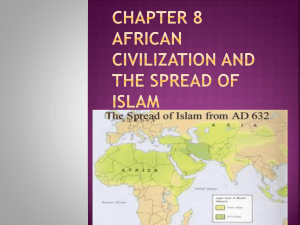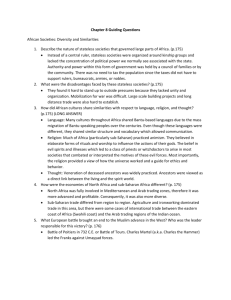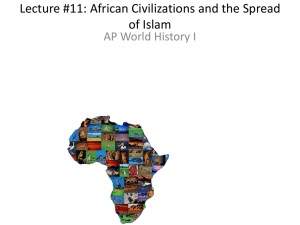African Civilization and the Spread of Islam
advertisement
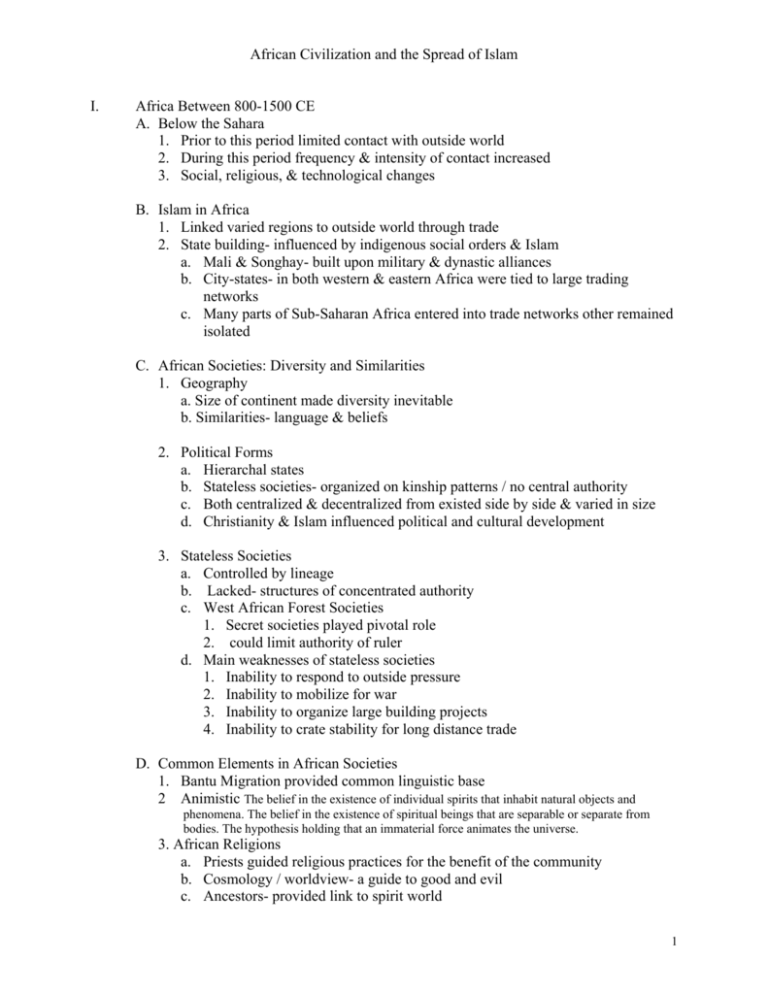
African Civilization and the Spread of Islam I. Africa Between 800-1500 CE A. Below the Sahara 1. Prior to this period limited contact with outside world 2. During this period frequency & intensity of contact increased 3. Social, religious, & technological changes B. Islam in Africa 1. Linked varied regions to outside world through trade 2. State building- influenced by indigenous social orders & Islam a. Mali & Songhay- built upon military & dynastic alliances b. City-states- in both western & eastern Africa were tied to large trading networks c. Many parts of Sub-Saharan Africa entered into trade networks other remained isolated C. African Societies: Diversity and Similarities 1. Geography a. Size of continent made diversity inevitable b. Similarities- language & beliefs 2. Political Forms a. Hierarchal states b. Stateless societies- organized on kinship patterns / no central authority c. Both centralized & decentralized from existed side by side & varied in size d. Christianity & Islam influenced political and cultural development 3. Stateless Societies a. Controlled by lineage b. Lacked- structures of concentrated authority c. West African Forest Societies 1. Secret societies played pivotal role 2. could limit authority of ruler d. Main weaknesses of stateless societies 1. Inability to respond to outside pressure 2. Inability to mobilize for war 3. Inability to organize large building projects 4. Inability to crate stability for long distance trade D. Common Elements in African Societies 1. Bantu Migration provided common linguistic base 2 Animistic The belief in the existence of individual spirits that inhabit natural objects and phenomena. The belief in the existence of spiritual beings that are separable or separate from bodies. The hypothesis holding that an immaterial force animates the universe. 3. African Religions a. Priests guided religious practices for the benefit of the community b. Cosmology / worldview- a guide to good and evil c. Ancestors- provided link to spirit world 1 d. Families, lineage, and clans had important roles in dealing with the spirit world & gods 4. African economies a. Extremely diversified b. North Africa- integrated into world economy c. Sub-Saharan region varied in structure 1. Agriculture & iron-working in postclassical period 2. Islam encouraged international trade in some regions d. Men & women- both important to market life e. In general raw materials were exchanged for manufactured goods f. Little is know about the size of African populations before the twentieth century II. The Arrival of Islam in North Africa A. Muslim Conquest 1. North Africa- integral part of trade in classical Mediterranean Civilization 2. Mid-seventh century- Muslims pushed westward from Egypt 3. Conversion a. Initially rapid b. North Africa- became divided into competing Muslim states 4. Islam & Unity a. Unity of political & religious world appealed to many rulers b. Social inequality existed & Islam prompted reform B. Role of the Berbers 1. Members of a North African, primarily Muslim people living in settled or nomadic tribes from Morocco to Egypt 2. Any of the Afro-Asiatic languages of the Berbers 3. Almoravids a. Western Sahara group c. Controlled lands between the southern Sahara & into Spain 4. Almohads a. 12th century b. Succeeded Almoravids ad dominant group C. Christian kingdoms: Nubia and Ethiopia 1. Christian states existed in North Africa prior to Islam a. Egypt- Copts had a rich & independent tradition b. Ethiopia 2. Byzantine oppression a. Caused them to welcome Muslim invaders b. Nubians (Kush) resisted Muslims until 13th century c. Ethiopia retained Christianity despite pressure D. Kingdoms of the Grasslands 1. Islam spread peacefully into sub-Saharan Africa a. Merchants followed caravan routes across Sahara b. Sudanic states 1. Ghana- 8th century 2. Mali, Songhay, & Hausa- 13th century 2. Sudanic States 2 a. b. c. d. e. Patriarchal Council of Elders- from family of lineage Ethnic core Rulers- sacred individuals separated from subjects by ritual Conversion 1. Majority of population didn’t convert 2. Regardless, arrival of Islam after 1oth century reinforced ruling power f. Mali & Songhay- most important states II. Mali & Songhay A. Empire of Mali 1. Located along the Senegal & Niger Rivers 2. Manlike- people who broke away from Ghana in 13th century 3. Islam- strengthened rulers 4. Economic base a. Agriculture b. Gold trade B. Mansa Musa 1. Mansa (ruler) Kankan Musa– made Mali powerful state 2. Pilgrimage to Mecca a. Legendary because of wealth & gifts b. Ishak al-Sahili 1. Returned with Suniata 2. Created distinctive Sudanic architecture utilizing beaten clay C. City Folk & Villagers 1. Jenne & Timbuktu / western Sudan Scholars Architects Foreign merchants Craft specialist 2. Timbuktu a. Center of academic knowledge b. Famous for its library & university 3. Majority & Farming a. Most people lived in villages b. Despite hardships eked out existence on family plots D. The Songhay Kingdom 1. Dominated middle reaches of the Niger River 2. 7th century- became independent state a. By 1010- Muslims ruled / capital Gao b. By 1370s- won independence from Mali & prospered as a trading state c. Amalgamation of traditional African beliefs & Islam 3. Moroccan Defeat 1591 -Songhay remained dominate state until this defeat 3 E. Political & Social Life in Sudanic States 1. Islam- provided universal law & served common interest a. Rulers reinforced authority through Muslim official & ideology b. Existing traditions & social organization continued 2. Indigenous political & social patterns persisted in unified states F. The Swahili Coast of Africa 1. Location a. Series of trading ports b. Part of Indian Ocean trading network c. Extended- from Horn of Africa to Mozambique 2. Region was influence by Islam, but most people maintained traditional / indigenous practices a. Culture always mixture b. Dominant culture- utilized Swahili language & incorporated Islamic and African practices 3. Costal Trading Ports- Bantu-speaking peoples reached region in 1st millennium CE 4. Immigrants from Southeast Asia migrated to Madagascar- 2nd century BCE 5. Rise of Islam- brought settlers from Oman & Persian Gulf 6. 13th century a. Bantu and Islamic culture emerged b. Bantu Swahili language 7. 30 towns flourish: Mogadishu Mombasa Malindi *Kilwa- 13th-15th century most important Pate Zanzibar Conclusion: The spread of Islam brought large areas of Africa into the global community. The most pronounced contacts south of the Sahara were the Sudanic states and east Africa where the fusion of Islamic and African cultures created an important synthesis. Most of Africa evolved in regions free of Islamic contact. In Benin, the Yoruba states, Great Zimbabwe, and the Kongo, Africans developed their own concepts of kingship and the state. Many other Africans organized their lives in stateless societies. 4
